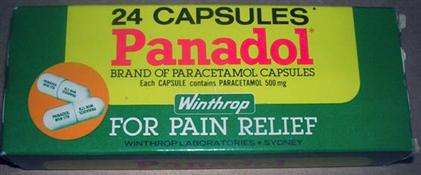
South Australian Medical Heritage Society Inc
Website for the Virtual Museum
Home
Coming meetings
Past meetings
About the Society
Main Galleries
Medicine
Surgery
Anaesthesia
X-rays
Hospitals,other organisations
Individuals of note
Small Galleries
Ethnic medicine
- Aboriginal
- Chinese
- Mediterran
Australian experience of analgesia
in the mid 20th centuryACKNOWLEDGMENTS: The photographs and information has been kindly provided by Don Burge, a retired pharmacist, and Terry Omond OAM, curator of the Calvary Hospital Museum .
Pain relief was an important part of medical treatment. The best known and oldest analgesics are derived are derived from the poppy (opiates) and the willow bark (salicylic acid). Opium was used by the Sumerians and Homer referred to it in the Iliad (900 BC). Laudanum, an opiate was often used in Victorian times. Morphine was synthetised in the early 1900. Because of the addictive effects of opium and its analogues the use was limited by the medical profession to intractable pain only.
Less severe pain was managed by Aspirin, Phenacetin and Codeine.
Salicylic acid (salacin) was produced in the 1830s and commercial Aspirin was developed by Hoffman in 1899 and made the Bayer drug company famous.
Phenacetin was introduced in 1887 as an analgesic and antipyretic. Australia developed its own pain killers such as BEX, Vincent’s APC and Veganin. They contained a mixture of aspirin phenacetin and caffeine or codeine and were popular. The side effects of phenacetin leading to interstitial nephritis and papillary necrosis resulting in renal failure, first reported in 1970 and phenacetin was removed from the pain preparations. Paracetamol which was known in the early 1900s as acetaminophen has become more popular recently.

Several samples of Australian analgesics used in the 1950s
.
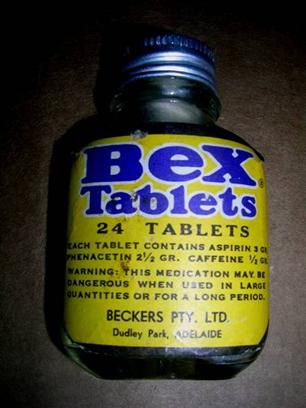
The manufacturer of BEX was the firm of Beckers in Dudley Park in SA. It is suggested that Prof. Mc. Beth from Adelaide University was associated with its development.
More common presentation of BEX was as a powder in paper sachets. It was extremely popular. It was taken by shearers each day as a stimulant and by process workers before each shift. It became an Australian icon and was publicised by the sentence from Philip Street Revue “A cup of tea, a BEX and a good lie down”. A much increased incidence of renal disease and failure was noticed by Dr. Kincaid-Smith of Melbourne in areas where BEX was popular and the cause attributed to the phenacetin contained in BEX This resulted in the removal of phenacetin from routine use by 1970,

“Veganin” was another analgesic. The caffeine has been replaced by codeine and the dose of phenacetin is higher than in Bex.

The doses are still in grains. “Veganin” is no longer sold.
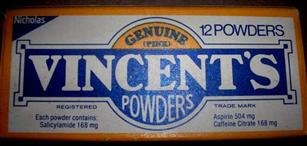
The Australian firm of Nicholas produced Vincent’s powders. They were originally marketed as “Vincent’s APC ” (aspirin, phenacetin and caffeine). Once phenacetin was found to be associated with renal failure, the composition was changed as shown in the illustration.
Faulding company is well known in South Sustralia . Their analgesic preparation “Faulding’s APC ” still contained phenacetin in 1960 ten years before the renal problems with phenacetin had been recognised.
Re Aspirin. A less irritating form of Aspirin was produced by Felix Hoffman, a chemist, for the German Company Bayer in 1897. He used sodium salts as buffers to reduce gastric irritation in order to help control his father’s arthritis. Thus Aspirin was born, Bayer patented it in February 1900 and the company is now global. The name “Aspirin” was formed by using A from A cetyl, SPIR from the SPIR ea plant which was a good source of methyl salicylate and IN, a common suffix in medications.
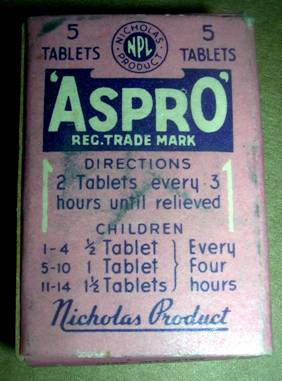
Nicholas “Aspro” (“aspirin”) showing indications.
and the price of six shillings and six pence.
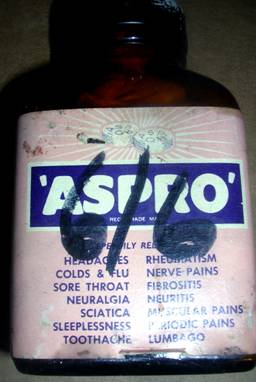
Asprin by the Bayers firm
who originally introduced it
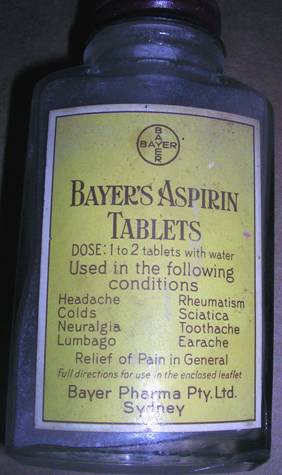
Because of the renal problems with phenacetin and the gastric and coagulation problems associated with aspirin, paracetamol is now the commonly used analgesic.
